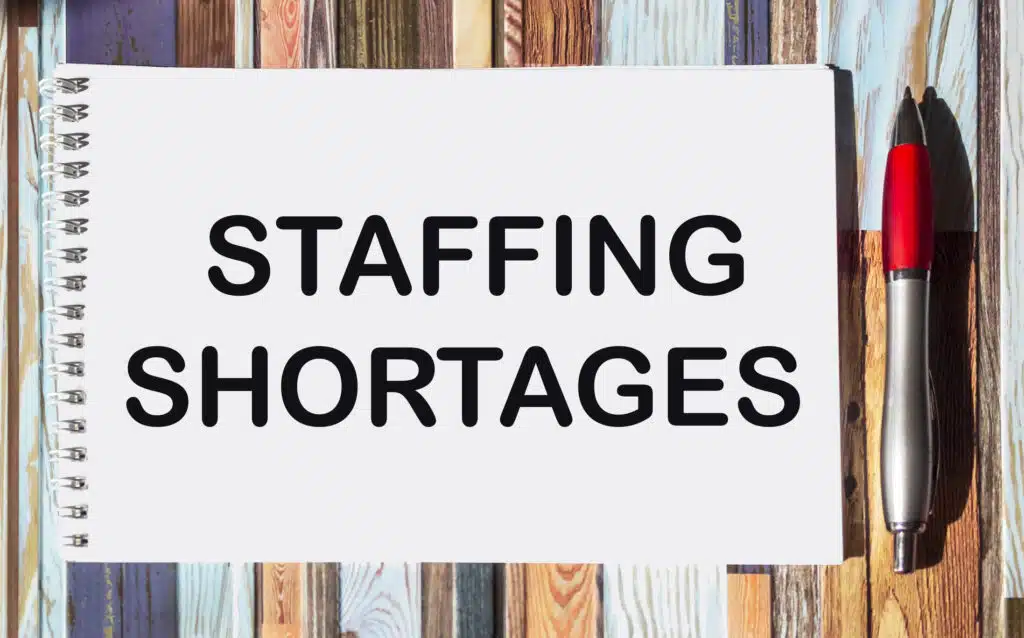Many organisations have reported staff shortages following the Covid 19 Pandemic, which impacts trading and revenue. To understand the size of the problem and to answer the question, can labour demand forecasting solve your staff shortages, we did a survey on the matter in October 2022.
We surveyed 35 UK and Irish customers with over 50,000 hourly paid staff between them. We won’t cover the full details here, but some key takeaways were
- 56% of those surveyed said – “We can’t meet our recruitment needs, and we are losing more staff than we are recruiting.”
- 55% of those surveyed said – “We are reducing opening hours because we don’t have enough staff.”
So the ability to fill all available positions costs businesses money and takes up a lot of management time. Most businesses will address this by focusing on recruiting and retention. But before you recruit more staff, you should consider why you think you have too few staff. Most likely, you are comparing the total number of staff hours you have available to schedule with the total number of hours that your current labour demand forecast says are required.
But what if your labour demand forecast is wrong?
In this blog, we will examine how an accurate labour demand can ensure you have the right staffing levels and whether it can solve your staff shortages.
We have written detailed articles explaining what Labour Demand Forecasting is, how it works and why you need it, and what approaches there are to deliver the forecast in our experience.

Why your Labour Demand Forecast might be wrong?
We often get involved in analysing existing demand forecasts, and there are many reasons they might be wrong. Here are some of the most common issues with labour demand forecasting models that we come across.
- There is no model: We often see companies with a standard working pattern that doesn’t change. It might have some weekly seasonality, such as more staff on a Saturday, but it wouldn’t meet the definition of a labour demand forecast.
- Too much manual input: Some labour demand forecasts have been created using spreadsheets with managers’ input. These can often contain conservative assumptions and biases. Often we find managers like to have a few extra staff just in case, even in quiet times, and this overstates the total hours required.
- The model is not updated often enough: We see companies with models for every role in every venue but the underlying model is never changed, so it doesn’t take into account seasonality, bank holidays or weather.
- There is no sales forecast first: more specifically, a series of forecasts of the factors that most correlate with staffing levels. This then relies on managers’ input again for a labour demand forecast.
- Every location uses the same model: We often see the same model used in every location, and yet they all have different staffing requirements at different times of the day.
- The model is too simplistic: Many organisations simply increase the number of hours by year on year for any growth in sales and spread those hours evenly across the week. We often see a 5% YOY growth in sales, which means that a manager has a few extra hours to spend as they see fit.
You should do your own analysis, but if you recognise that you are making some of the same mistakes, then maybe you don’t have a staff shortage after all.
How can Labour Demand Forecasting solve your staff shortages?
Yes, it can, let’s look at how it can do that. If you have an accurate AI-Powered Labour Demand Forecast that meets best practices and shows that you need fewer total hours and you have enough staff to meet those hours, then you don’t have shortages. You have too many hours in your current labour demand forecast, and you only thought you had a staff shortage.
Often the demand curve redistributes hours from quiet times to peak and will always prioritise peak as this is the greater opportunity for revenue growth. If your previous model was “carrying a lot of fat” then you may not have a labour shortage at all.

Does this work in practice?
So you might be wondering, can labour demand forecasting solve your staff shortages in practice? Yes, it does work in practice. We have implemented our end-to-end AI-Powered Workforce Management Software for a customer with 5,000 staff in 52 venues, and before we started, they believed they were short of staff. The AI-powered system is now scheduling to the demand forecast, and they no longer have gaps. Therefore they now have enough staff to meet their demand requirements.
Conclusion
Labour demand forecasting is an essential tool for businesses. If you are suffering from staff shortages and cannot fill all of your shifts, why don’t you see if your demand forecast is correct before paying extra to recruit more staff? You may still need to recruit, but the numbers required may not be less than you first thought.




